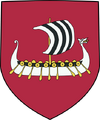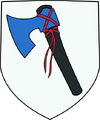Skellige, commonly referred to as the Skellige Isles or the Isles of Skellige, is an archipelago and one of the Northern Kingdoms. The group of six islands is situated in the Great Sea, off the coast of Cintra and southwest of Cidaris and Verden. It's legendary, famous for the unrivaled corsairs and swift longships that sail many seas.
Its people are united under the King of the Skellige Isles, who's elected by the jarls of the seven major clans during traditional moots. In practice, however, the kings are from the same clan or at least related.
Even though their relations with most of the North were always tense, to say the least, they were longtime allies of Cintra, due to the marriage between Queen Calanthe and Eist Tuirseach of Skellige. After King Eist's death in the Battle of Marnadal, the Islanders concentrated their raids on the Nilfgaardian Empire in an act of revenge.
History[]
Prehuman ages[]
Before the first appearance of a human, the isles were apparently inhabited and dominated by Aen Seidhe elves who shared it with giants and ice giants.[2]
Formation of the kingdom[]
Humans who came to settle the isles had first divided themselves into independent clans with jarls, clan chieftains, as sovereign rulers of their respective islands.
Thus were the petty jarldoms of Skellige, small in size, several times invaded by rising powers of the Continent throughout the years. Most menacing of such invaders being Cidaris whose kings made attempts at full insurrection, however, no one ever managed to conquer them.[3] On the contrary, the threat of larger kingdoms and uncivilized barbarians from smaller islets further away caused Skelligers to unite. Skellige then became an elective monarchy, ruled by a king chosen from among the jarls.[2]
Northern Wars[]
In 1263, during the First Northern War, Skellige received refugees fleeing the conflict in Cintra, after their capital was sacked.[4] The Islanders sought revenge by beginning to focus their raids on the Empire, raising political tension between the two countries, and by the start of the Second Northern War in August 1267, an Imperial blockade was installed across the mouth of the Yaruga, restricting the archipelago's shipments and aid from Redania.[5]
National emblems[]
The most commonly recognized emblem of Skellige was a silver drakkar, placed on either purple[3][6] or bloodred.[2] The Jarls of Skellige Isles, who lead the reigning monarch's armies, since ancient ages have used the emblem of Blue Axe.[7]
The following illustration has been created by Wiki editors basing on official description and/or depictions.

The following illustration has been created by Stanislav Komárek, Sapkowski's associate and translator.
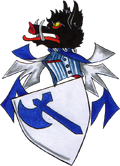
The following illustration has been used in CD PROJEKT RED's The Witcher franchise.
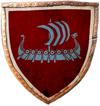
Notable Skelligers[]
For the main article on Skellige kings, see King of the Skellige Isles.
Royal family
- Crach an Craite
- Hjalmar an Craite
- Cerys an Craite
- Loki (non-canon)
- Ragnar (non-canon)
- Birna Bran
- Svanrige an Tuirseach
Locations[]
Other locations
Culture[]
Clans[]
A clan is a kinship group among the Islanders, giving its members a sense of shared identity and descent. Skellige is divided into seven clans, each seated on one of the archipelago's larger islands. At the base of each clan are kins led by a so-called bonds;[8] bonds, in turn, are then led by the clan chieftain called jarl[8][2] (not to be confused with the "Jarl of Skellige" which refers to the main commander of the armed forces[9]).
Every Skellige clan has its own insignia and characteristic colors that define it as a distinct group bound by family ties and age-old traditions. These colors also act as a distinguishing mark that lets warriors easily identify each other on the fields of battle. They appear on clothing, sails, shields, and tartans.[2][10]
Other groups[]
People[]
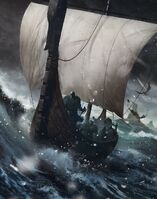
Skelliger warriors on a drakkar
The inhabitants of these cold and windy isles are called simply the Islanders, by other Northerners on the Continent in particular. They are renowned as hard, tough, and decent men, while at the same time frightening when attacking their foes.[10] They are a nation with deeply rooted seafaring tradition and, although their harbors cannot compare to those in Cidaris in terms of the number of completed units a year, the Islander's drakkars are feared throughout the waters of the north and south because of the rage and knowledge these people possess.[11] The Islanders themselves proudly state that "they have the sea in their blood".[12]
The people, however, are not only backward corsairs and plunderers as most Continentals powers see them. Quite a number of them are fishers, jewelers, merchants, alchemists, or other common professions and at least two examples of a classic mage are recorded: Marquard[11] and Astrid Lyttneyd Ásgeirrfinnbjornsdottir.[12] In contrast to the North, the Islanders are predominantly free and posses rights nearly equal to those of the jarls and kings who lead them as the gap between higher and lower classes is milder.[13] While being able to speak without a problem in the Common Speech, they have their own language, the Skellige jargon, based on the Hen Llinge.[4]
Many of the Skalds that hail from the isles utilize bagpipes. The inhabitants domesticated bears and utilize them in warfare. On the Skellige Isles, women and men stand on legally equal footing, and both train in arts of war and seafaring.[3] In practice, however, certain discriminatory beliefs still persist; it is much harder for a woman to reach a ruling position.[2]
Religion[]
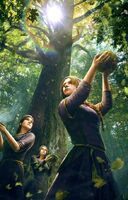
Priestess of Freya
The Gods of the Sea and goddess Freya are chief objects of worship throughout Skellige. Undoubtedly, the latter is revered by the Islanders above all other deities, and she is a central figure in their religious system. They grant her the venerable title of the great modron, meaning "mother" in their tongue, for Freya is the patron of fertility, love, and beauty. She also poses as the patron of soothsayers, clairvoyants, telepaths, as symbolized by her sacred animals: the cat, which sees and hears while being unseen, and the falcon, who watches everything from the sky, and by her jewel: the necklace of foresight Brisingamen.[11]
Apart from these, Islanders revere mythical hero Hemdall,[11] his mistress Heulyn, and their children, founders of the most powerful clans and the first alleged rulers of the archipelago: Grymmdjarr, Modolf, Broddr, Otkell, Sove, and Tyr.[2] They also trust and believe in local druids, who are seen as wise men and act as diplomats, royal advisors, warriors, and wielders of magic.[10]
There are also two forgotten deities: Svalblod and Melusine. Svalblod was worshiped by a cult cast out of Skellige, for even in a land of violence-orientated culture, these worshipers practiced rituals so drastic that they repulsed the minds of many. When it got too far, jarls brought an end to it and by 1272 only the henge in Fornhala remained standing.
Melusine was a siren but was so strong, large, and different from the others that some Islanders worshiped her as a semi-divine being. She hibernated in a cave at the southern cliffs of Spikeroog, leaving at times to hunt. The locals feared her enough to worship her and even built a massive shrine in her cave, remembering her as the mad and dangerous Lady Melusine of the Depths.[2]
The Witcher 3: Wild Hunt[]
Map description[]
- The Skellige Archipelago is home to fierce warrior-sailors whom Continentals regards as pirates - and not without reason, for the Isles are barren and their inhabitants' livelihood comes mainly from plundering the seas. The land on these five large isles is divided between its clans, the heads of which are called jarls.
Gwent: The Witcher Card Game[]
Reward Tree entries[]
- Scroll 1: A smattering of rocks jutting out of the sea, with more sheep than people. At first glance, just a collection of drunkards, unruly shepherds, and rowdy fishermen. Never had a nation seemed so easy to conquer. Or so thought many a leader on the Continent. One after another they came, shattering teeth and bone on the islands' craggy shores...
- Scroll 2: But how is it the Skelligers have managed to ward off the Nilfgaardian armada, and incursions from Cidaris? Many attribute their failures to the fierce storms that shatter ship against rock. Little else gets Skelligers to chuckle as much as such excuses.
- 'Scroll 3: Skelligers are of a particular mindset. Can't swim in a storm? Go dawdle in the dirt. Can't brawl on a bluff? Then fiddle in a field.
- Scroll 4: Indeed, Skelligers are cut from a different cloth than their landlubbing counterparts on the Continent. They're more rugged, sturdy, more resistant to pain. And most importantly, rather than fear death, they await its glorious arrival.
- Chest 1: In the Skellige Isles' rich pantheon of gods, the most prominent place belongs to Freya – goddess of love, fertility, hearth, and harvest. Many consider her the same deity as the beloved Melitele, who is worshipped on the mainland. Though this is best left unsaid on the islands, for Skelligers would consider such a comparison as sacrilege. Freya is also the patron goddess of soothsayers, seers, and telepaths, a fact demonstrated by her associated symbols: a cat who sees and hears what is hidden; a falcon that observes from high above, and Brisingamen – the prophetic necklace of legend.
- Chest 2: The Skellige Isles are home to seven clans: Brokvar, Dimun, an Craite, Drummond, Tordarroch, Heymaey and Tuirseach. Members from each considers themselves to be the strongest and the bravest – and any would eagerly duel those who dare question their might. That said, Skelligers recognize authority over the Isles in one king, chosen by popular vote. And who is eligible to have their name considered? Any and all – regardless of sex, age, or lineage.
- Chest 3: Skelligers are more closely bound to nature than most on the Continent. Nowhere else do druids command so much respect as in Skellige. Nowhere else do hunters treat animals with such regard. In no other army's ranks do bears roar with such ferocity.
Trivia[]
- Skellig(e) derives from the Irish (Gaeilge) "Sceilg", which can be translated into "Rock" or "Cliff". There are also Skellig Islands in the Atlantic Ocean, part of Ireland.
- In the book The Tower of the Swallow, the residents and the belief of Skellige largely resembles a mix between the real-world "Vikings" and Norse mythology and that of the ancient Irish and Scottish Cultures. In this way the Skellige people almost certainly resemble the real historical people known as the Norse-Gaels who were a hybrid culture of the Gaels and Norsemen. A similar resemblance can be observed in The Witcher 3: Wild Hunt.
- In keeping with the Gaelic and maritime theme, the background music that plays in Skellige in The Witcher 3: Wild Hunt has lyrics in Scottish Gaelic, namely the first verse and chorus lines of the folk song "Fear a' Bhàta" ("The Boatman"). "'S tric mi sealltainn on chnoc as àirde" ("Often I watch, from the highest hill").
- In The Witcher 3: Wild Hunt, their clothing is modeled on an early medieval dress worn in Northern Europe.[14]
Notes[]
- A custom of the isles dictates that a girl has the right to a costly gift from her first lover. Ciri made use of this to justify taking the deceased Hotspurn's beautiful mare that she then named Kelpie.[11]
Videos[]
References[]
- ↑ Unlike many other nationalities, where the demonym is also an adjective (like Temerian sword), "Skelliger" is only for nationality while "Skelligan" is the adjective (like the difference between using "Spaniard" and "Spanish").
- ↑ 2.0 2.1 2.2 2.3 2.4 2.5 2.6 2.7 The Witcher 3: Wild Hunt
- ↑ 3.0 3.1 3.2 Gwent: The Witcher Card Game
- ↑ 4.0 4.1 Blood of Elves
- ↑ Baptism of Fire
- ↑ Blood and Wine expansion
- ↑ Stanislav Komárek
- ↑ 8.0 8.1 Wiedźmin: Gra Wyobraźni
- ↑ Genalogy of Ciri - Eist
- ↑ 10.0 10.1 10.2 The Last Wish
- ↑ 11.0 11.1 11.2 11.3 11.4 The Tower of the Swallow
- ↑ 12.0 12.1 Season of Storms
- ↑ The World of the Witcher
- ↑ The Witcher 3: Wild Hunt Artbook
| Kings | |
|---|---|
| Consorts | |
| Jarls of Skellige | |
Major regions
| |
Minor regions
| |
In expansions
|


